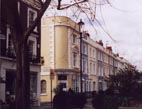
Route & what to see
|
A Notting Hill Walk Route & what to see |
| london-footprints.co.uk |
Notting Hill is known for a number of things; the huge Carnival that takes place on August Bank Holiday weekend, the Hugh Grant film and the Portobello Road with its market. Until 1864 there was still a Tollgate, on the site of the station (originally built in 1868). Gravel pits had been dug along present Notting Hill Gate and although this area was quite developed in 1841 lanes led northwards across fields to Notting Barn and Porto Bello Farms. What was to become the Ladbroke Grove estate was at this time the Hippodrome Racecourse and alongside this were the Potteries & Piggeries, notorious slum areas. Colourful terraces and interesting shops feature on this walk along with 4 cinema buildings. The busiest day is Saturday but there are some stalls on other days.
This 2¼ mile walk begins at Notting Hill Gate tube station and finishes at Holland Park tube station. A longer route is available [click here]
Exit onto the south side of
Notting Hill Gate and go east turning into Kensington Church
Street. Go right at Kensington Place, right at Jameson Street and
left at Hillgate Place.
This area was developed in the 1850s but by 1861 most of the
houses were in multiple occupation.
Go right at Hillgate Street
At the end is the Coronet, which built in 1898 as a theatre
converted to a cinema 20 years later
Go right along Notting Hill
Gate
On the right is the Gate Cinema
Cross into Pembridge Road
To the left in Kensington Park Road is the Kensington Temple and
on an island opposite one of the 13 remaining cabmen's shelters.
[more
info]
Continue along Pembridge Road
and turn left into Portobello Road
Number 22 has a blue plaque to George Orwell. In
Westbourne Grove to the left the building now an antiques centre
was the 20th Century Cinema opened in 1866 as the Victoria Hall,
later becoming the Bijou.
Continue along Portobello Road
The market began in the 1860/70s as a herb and horse-trading
centre for local gypsies. There are antiques & collectables
at the southern end, fruit & vegetables in the centre and new
& second-hand goods at the northern end. Along on the left is
the purpose built Electric Cinema of 1911. Notice the box office
and tiled floor in the foyer.
Go left at Blenheim Crescent,
left at Kensington Park Road then right along Elgin Crescent.
Follow this through to Clarendon Road then cross this into
Portland Road. Go ahead into Avondale Park.
Opened in 1892 this former area of slurry called 'the Ocean' was
part of the notorious Piggeries as well as the location of tile
kilns and brickfields.
Exit into Walmer Road further
along where a tile kiln remains. Go to the right alongside the
church of St Francis of Assisi (Pottery Lane) then first left
along Penzance Place back into Portland Road.
Hippodrome Place on the left is a reminder of the Racecourse that
once covered a large area here from 1837-42.
Go to the right here along
Clarendon Cross, then right at Clarendon Road
To the left at the end of St John's Gardens is the church of
1845
Continue to the end of Clarendon Road and go left at Holland Park Avenue to the station.
© london-footprints.co.uk 2011
There are Notting Hill walks in
'Walking London' by Andrew Duncan and 'Time Out Book of London
Walks 2'
Historical Publications have produced an illustrated book
'Notting Hill & Holland Park Past' by Barbara Denny
[booklist] [walks list]